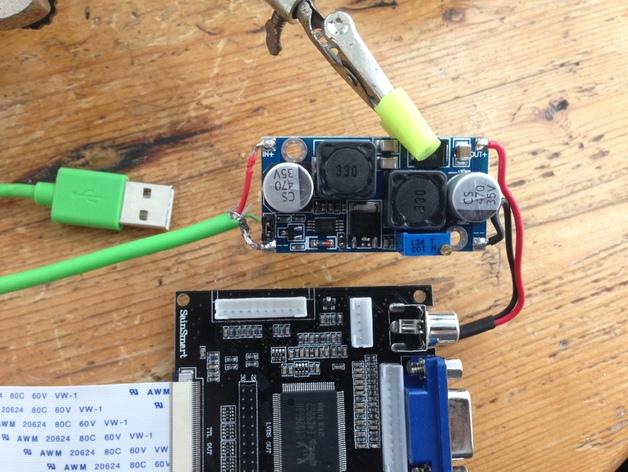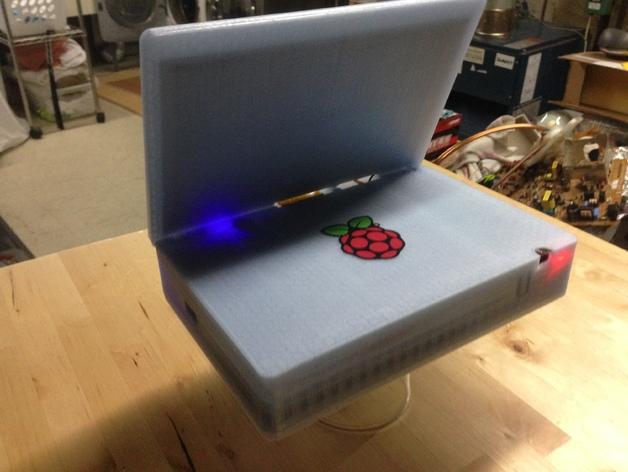 Recently, we did a story on an engineer who had 3D printed a wirelessly powered Tesla desk lamp. Created by David Choi, it was able to be powered without any wires connecting it to the source. It was quite the clever creation, and Choi received a lot of positive feedback on his design.
Recently, we did a story on an engineer who had 3D printed a wirelessly powered Tesla desk lamp. Created by David Choi, it was able to be powered without any wires connecting it to the source. It was quite the clever creation, and Choi received a lot of positive feedback on his design.
Like a lot of engineers, however, Choi is never satisfied. He is always looking to create new products, new inventions, and new iterations upon already existing products. Today he has informed 3DPrint.com that he has utilized the same basic technology in his desk lamp to create a one-of-a-kind wirelessly powered and wirelessly charged Raspberry Pi 2 computer, which he calls the PiBook.
“I wanted to evolve the wireless lamp into something a bit more practical,” Choi tells 3DPrint.com. “What could be more practical than a computer? The Raspberry Pi 2 was just released, so I decided why not build a wirelessly powered open source computer? I’ll throw in a touch screen to boot. The only difference between this power receiving circuit and the lamp circuit is that the power needed to be rectified to DC and brought down to a safe operating voltage for the electronics.”
A while back Choi set out to create a wirelessly charged cell phone case, a project which he ended up abandoning. However, what he learned from that endeavor aided him greatly in creating this unique computer, particularly when it came to the coil setup within his design.
“I knew the coil wouldn’t need as many winds (one wind was enough) so I could make the coil small enough to fit in the footprint of the screen itself, which determined the overall dimensions of the computer,” Choi tells us. “The rest of the innards involved final placement of the Raspberry Pi, the video board, a voltage boost converter, the coil voltage regulator, and the battery.”
 The board used for the touchscreen was taped into place over the Raspberry Pi, fitting quite nicely. Choi then needed a voltage boost converter to convert the 5V supplied by the battery to the 12V needed for the screen to operate. He took a voltage regulator, and set it to output 5V to the battery and the Raspberry Pi, so that his PiBook could be charged while it was running. He then placed all of the required buttons and outputs in the correct locations.
The board used for the touchscreen was taped into place over the Raspberry Pi, fitting quite nicely. Choi then needed a voltage boost converter to convert the 5V supplied by the battery to the 12V needed for the screen to operate. He took a voltage regulator, and set it to output 5V to the battery and the Raspberry Pi, so that his PiBook could be charged while it was running. He then placed all of the required buttons and outputs in the correct locations.
Everything but the coil and the electronics was 3D printed on Choi’s MakerBot Replicator 5th Generation 3D printer. The lid of the PiBook, which contains the screen, was printed in two separate parts with conduits in them for wiring. The 3D printed buttons are tabs with three-quarters of the profile cut out so that they can bend, yet also stay in place quite well. The 3D printed body features supports for all of the various boards and input/output jacks.
“The hardest part was getting all those wires to fit inside as tightly as possible,” Choi explains. “I ended up buying 4 different HDMI cables until I settled on an ultra thin 1 ft HDMI cord which worked perfectly.”
 As for how the PiBook operates, it features a tunable 6.5Mhz, 30W transmitter built into the underside of the table portion. The small double-wind coil (0.34uH) is inductively coupled to a larger (5.80uH) loop antenna which has a high quality factor, meaning it is efficient at storing reactive power. The antenna is also tunable and set to a resonance of 6.5MHz. The receiver is a single loop, loaded with a 3.3nF capacitor which brings the coil into resonance at 6.5MHz.
As for how the PiBook operates, it features a tunable 6.5Mhz, 30W transmitter built into the underside of the table portion. The small double-wind coil (0.34uH) is inductively coupled to a larger (5.80uH) loop antenna which has a high quality factor, meaning it is efficient at storing reactive power. The antenna is also tunable and set to a resonance of 6.5MHz. The receiver is a single loop, loaded with a 3.3nF capacitor which brings the coil into resonance at 6.5MHz.
“I did not need more winds since I only needed to ultimately supply 5VDC,” Choi tells us. “Again, this is where 3d-printing shines. All I had to do after making my calculations and printing the loop outline was lay the 1/8″ copper tubing into place. It was a snap fit.”
The PiBook works by using the electricity which is transferred through magnetic coupling using four coils. The first coil is the primary transmitting coil, and it transmits power to the large secondary receiving coil. The third coil is the single loop, and fourth is also a single loop which has the ability to pick up the fluctuating magnetic field of the third and then deliver 6.5MHz of AC power to a bridge rectifier which converts it a DC current. And voilà! You have a working, wirelessly powered Raspberry Pi 2 computer, called the PiBook.
Simple enough, right? If you really think so, then you can download the designs and 3D print your very own PiBook via Choi’s Thingiverse page. If you are like me and totally lost by all of this technical talk, you can still check out Choi’s video of the PiBook in action below. What do you think about this unique creation? Discuss in the PiBook forum thread on 3DPB.com.
Subscribe to Our Email Newsletter
Stay up-to-date on all the latest news from the 3D printing industry and receive information and offers from third party vendors.
You May Also Like
Hyliion CEO Thomas Healy on 3D Printing’s Role in the KARNO Generator
While the electric vehicle (EV) market faces an uncertain future, there’s no uncertainty about the fact that greenhouse gas emissions are drastically changing the climate on Earth. Thanks to its...
Attending the ASTM F42/ISO TC 261 Meetings: The Nitty-Gritty of Additive Manufacturing
I never thought I’d be so excited about an event focused on additive manufacturing (AM) standards, but here we are! When I learned that the recent biannual ASTM F42/ISO TC...
World’s Largest Polymer 3D Printer Unveiled by UMaine: Houses, Tools, Boats to Come
The University of Maine has once again broken its own record by unveiling the largest polymer 3D printer in the world. Surpassing its 2019 achievement, the new Factory of the...
Gorilla Sports GE’s First 3D Printed Titanium Cast
How do you help a gorilla with a broken arm? Sounds like the start of a bad joke a zookeeper might tell, but it’s an actual dilemma recently faced by...































